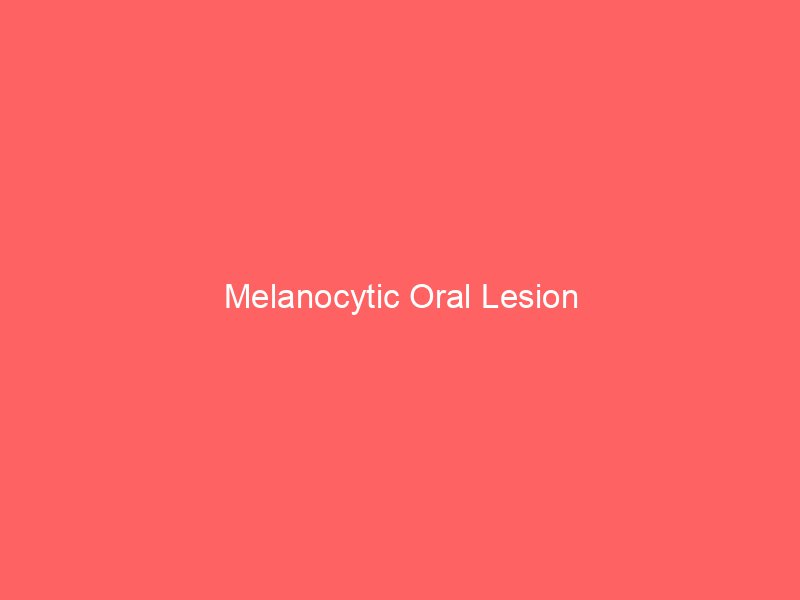Melanocytic oral lesion refers to a growth or lesion that is formed in the mouth due to the presence of cells called melanocytes, which produce pigment (melanin). These lesions can be either benign (non-cancerous) or malignant (cancerous) and can vary in appearance, size, and location within the mouth.
The most common benign melanocytic oral lesion is a pigmented macule, which is a flat, discolored spot that is not raised above the surrounding skin. Other benign melanocytic oral lesions include nevi, which are small, dark brown or black spots, and lentigines, which are larger and often have an irregular shape.
Causes
Melanocytic oral lesions are growths that occur in the mouth due to the overproduction of pigment-producing cells called melanocytes. The main causes of these lesions include:
- Sun exposure: Prolonged exposure to the sun can cause melanocytes to produce an excess of pigment, leading to the formation of a melanocytic oral lesion.
- Genetics: Some individuals may have a genetic predisposition to develop melanocytic oral lesions.
- Age: As individuals age, their skin and oral tissues can become more susceptible to sun damage and the formation of melanocytic oral lesions.
- Medical conditions: Certain medical conditions, such as systemic lupus erythematosus, can increase the risk of developing melanocytic oral lesions.
- Tobacco and alcohol use: The use of tobacco and alcohol can also increase the risk of developing melanocytic oral lesions.
- Certain medications: Certain medications, such as phenothiazines, can increase the risk of developing melanocytic oral lesions.
It is important to note that not all melanocytic oral lesions are cancerous, but it is important to have any new growths or changes in existing growths evaluated by a healthcare provider. Treatment options for melanocytic oral lesions include surgical excision, laser therapy, and topical medications.
Symptoms
Melanocytic oral lesion is a type of skin condition that affects the mouth and is characterized by the presence of dark spots or patches on the inside of the cheek, gums, tongue, or lips. The main symptoms of melanocytic oral lesion include:
- Dark spots or patches: The most noticeable symptom of melanocytic oral lesion is the presence of dark spots or patches on the inside of the mouth. These spots may be uniform in color or have an uneven appearance.
- Swelling or lump: The dark spots may be raised and swollen, leading to the formation of a lump in the mouth.
- Bleeding or ulceration: The lump may ulcerate or bleed, causing pain and discomfort.
- Pain or discomfort: Some people with melanocytic oral lesion may experience pain or discomfort in the affected area.
- Change in size or color: Over time, the dark spots may change in size or color, becoming darker or larger.
It is important to note that melanocytic oral lesion can be benign or malignant. A biopsy may be necessary to determine the type and stage of the lesion. Treatment options may include surgical removal, radiation therapy, or chemotherapy.
Diagnosis
The main diagnosis test for melanocytic oral lesions is a biopsy. A biopsy is a sample of tissue taken from the suspicious lesion, which is then examined under a microscope. The biopsy will determine the type of cells present and whether they are benign (non-cancerous) or malignant (cancerous).
A biopsy can be performed in a number of ways, including:
- Punch biopsy: A circular blade is used to remove a small circular piece of tissue.
- Excisional biopsy: The entire lesion is removed, along with a small margin of surrounding tissue.
- Incisional biopsy: A portion of the lesion is removed for examination.
In addition to a biopsy, imaging tests such as an X-ray, MRI, or CT scan may be performed to determine if the lesion has spread to other parts of the body. Blood tests may also be conducted to check for the presence of cancer markers.
It is important to have any suspicious oral lesions evaluated by a dentist or oral surgeon as soon as possible to determine the best course of treatment.
Treatment
The most common treatment options include:
- Electrosurgery: This is a procedure in which a current is used to remove the lesion.
- Laser therapy: This is a procedure in which a laser is used to remove the lesion.
- Observation: For small and non-progressive lesions, observation may be recommended. The lesion will be monitored for any changes and biopsy may be performed if necessary.
- Surgical excision: This is the most common treatment for melanocytic oral lesions. The lesion is removed along with a small margin of surrounding tissue to ensure that all of the abnormal cells have been removed.
- Cryotherapy: This involves freezing the lesion with liquid nitrogen. This is a simple and effective method of treatment, but it may cause scarring and may not be suitable for larger lesions.
- Photodynamic therapy (PDT): This involves the application of a photosensitizing agent followed by exposure to a specific type of light. This treatment can be effective for small, superficial melanocytic lesions.
- Topical imiquimod: This is a topical cream that stimulates the immune system to attack the abnormal cells. It is often used for small, superficial melanocytic lesions.
- Radiation therapy: This involves the use of high-energy radiation to destroy the abnormal cells. This treatment is generally reserved for larger or more advanced melanocytic lesions that cannot be treated by other means.
- It is important to note that not all melanocytic oral lesions require treatment. Some may disappear on their own, and others may not pose any significant threat to health. A biopsy may be necessary to determine the nature of the lesion and to guide the appropriate treatment.
It is important to seek treatment for oral melanocytic lesions to rule out any underlying malignancy. Early diagnosis and treatment can improve outcomes and prevent the spread of cancer.
